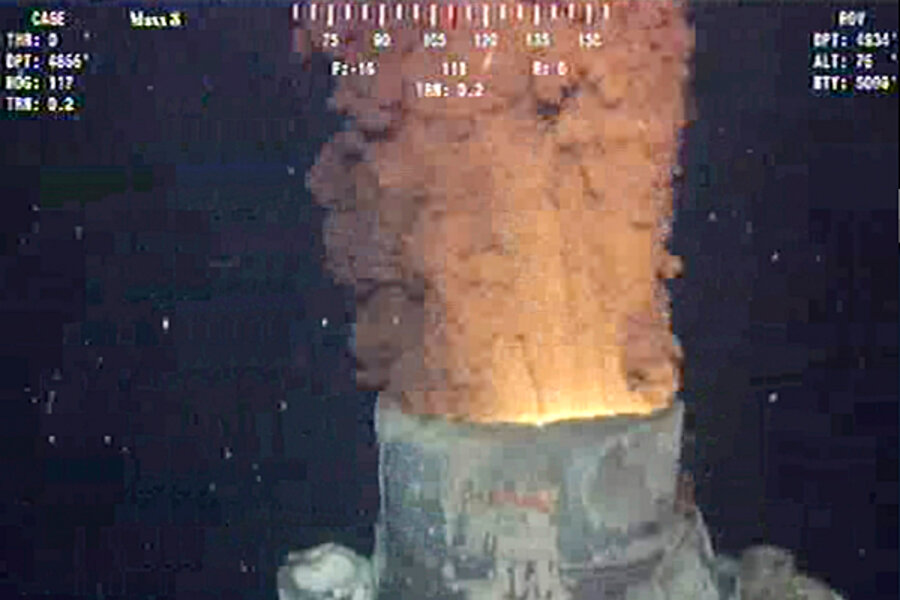Gulf oil spill study's surprising find: Bacteria ate methane in three months
Loading...
A new report is offering a potentially remarkable answer to a question that vexed scientists during the Deepwater Horizon blowout last year.
As oil and methane were pouring into the Gulf of Mexico from April to July, scientists sought to understand how quickly bacteria in deep Gulf waters would consume the gas. Initial rough estimates suggested that bacteria might take years.
Moreover, because the bacteria use oxygen dissolved in sea water as they eat, there were questions about how that bacterial banquet might draw down oxygen levels – to the detriment of other organisms living at those depths.
According to the new study, bacteria took fewer than four months to finish off the methane, and it appears that at no time did oxygen levels in the area the team studied fall to levels dangerous to marine organisms there.
"This was a surprise for us," says John Kessler, a chemical oceanographer at Texas A&M University, who, along with David Valentine at the University of California at Santa Barbara, led the study. "The process was very speedy."
By the end of July and into the beginning of August, methane decomposition rates in the broad area the team studied "were faster than had ever been recorded in any other place on the planet."
Other researchers working on the same issue are cautious about the results, suggesting the team may be overinterpreting its data.
"It's a bold hypothesis," says Samantha Joye, a marine biologist at the University of Georgia at Athens, who also has been gathering methane-related measurements since the blowout on April 20. But "there are other, alternate hypotheses that could just as easily explain" the data.
Dr. Kessler acknowledges the team's study isn't the final word on the subject. "The story will definitely evolve as we learn more about how these events change given rates of release, depth of release," and other natural variables, he says. "But I think we have a fairly conclusive story here."
How the team did it
The team first went out in June to measure methane and other hydrocarbon gases from the blowout. At the 31 locations it checked, the team found that microbes were quickly dispatching ethane and propane. But methane concentrations remained relatively high. Based largely on those initial measurements, which were published in October in the journal Science, the team estimated that it could take up to a few years for bacteria to remove the methane.
In late summer and into the fall, the team returned to sea on three cruises to get an update on the methane's status. This time, they cast a wide net, sampling methane and oxygen concentrations at 207 stations distributed over some 36,000 square miles of ocean west of the blowout site.
To their surprise, the researchers found that methane levels at their sampling sites never exceeded the normal background levels measured in the Gulf. By measuring the level of dissolved oxygen and using that data as evidence of microbial activity, readings showed that bacterial activity was still taking place. Other instruments registered the presence of oil-related hydrocarbons.
When the team conducted DNA studies of the bacteria at the deep-water sampling sites, they found that methane-loving varieties represented from 5 to 36 percent of the microbial populations – relatively high by the standards of low-methane waters. Given the low concentrations of methane at the sites, the team concluded that they were catching snapshots of a waning population of methane-consuming bacteria, which had finally run short on fuel.
The team estimates it took populations of methane-consuming bacteria two months to move into high gear. During those two months, the methane plumes gradually dispersed into less dense clouds spread over a broader area, meaning that the oxygen drawdown was never severe in any one location.
Questioning the conclusion
But Dr. Joye says she remains unconvinced. Among her qualms: The area is not well stocked with trace elements the bacteria need to survive – among them, copper, which bacteria specifically use to deal with the methane. Shortages of copper, as well as other trace elements, likely would have slammed the brakes on the exponential growth in bacterial populations needed to get rid of the methane in fewer than four months.
The team may not have found any methane because the water masses holding it had moved out of the area, she suggests. Other teams have had difficulty trying to find water masses they measured previously, she notes.
"I would be thrilled if I could sit here and tell you, 'Yeah, the methane's all gone, isn't that wonderful?' " Joye says. But "500,000 tons of methane does not get microbially consumed in three months."
The new study was published Jan. 6 on Science Express, the online adjunct to the journal Science.


